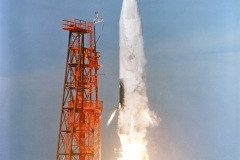Mercury-Atlas 5 (MA-5) was a mission as part of the American Mercury program with the chimpanzee Enos on board.
Five hours before launch, Enos was placed in the capsule in his spacesuit. The launch took place on November 29, 1961 at 15:08 UTC. Enos was trained to pull levers in response to certain stimuli, whereupon he was rewarded with water and banana pieces or, if he made a mistake, punished with electric shocks. Towards the end of the flight, however, the mechanism failed, so that Enos received electric shocks despite correct reactions. Nevertheless, Enos continued to carry out the tasks.
At the end of the first orbit, the ground crew noticed that the clock in the capsule was ahead by 18 seconds. The clock was synchronized again while flying over Cape Canaveral. Shortly afterwards, the transfer ship in the Atlantic received the first signs of rising temperatures in the capsule. These were confirmed by the transmission station in the Canary Islands. The temperature rose from 18°C to 26°C. This also caused Enos’ body temperature to rise from 37.3°C to 38.1°C. However, the body temperature stopped rising, which led the medical observers to conclude that the cooling system was working again.
A metal splinter in a fuel supply line also caused one of the right-hand rotating engines to fail. The failed engine caused the spacecraft to drift from its normal flight attitude. This drift caused the automatic stabilization and control system to correct the spacecraft’s attitude. Because of this, the capsule slowly drifted out of its intended orbit before a corrective thrust brought it back again. This was repeated nine times before the reentry engines ignited and then again before reentry itself. This resulted in more fuel being used than planned. Towards the end of the second orbit, the doctors wanted to send Enos to a third orbit, but the engineers were concerned that there would not be enough fuel. Flight Director Chris Kraft ultimately decided to reenter after the second orbit.
The US Navy destroyers USS Stormes and USS Compton as well as a Martin P5M were waiting in the recovery area. The capsule was spotted by the aircraft three minutes before splashdown at an altitude of 1,500 meters. This remained until the arrival of the USS Stormes, an hour and 15 minutes later, and documented the splashdown southeast of Bermuda. The capsule was brought aboard the destroyer and the hatch was blown off in a controlled manner. It was triggered from outside the capsule by pulling on a loop. Enos was in good health.
On November 4, 1962, Enos died of dysentery caused by shigellosis, which was resistant to the antibiotics of the time. He was under constant observation for two months before his death. Pathologists at Holloman reported that they found no symptoms that could be traced back to or related to his spaceflight a year ago.
With this successful flight, the Mercury capsule and the Atlas rocket were qualified for manned flights into space.
Mission data |
|
|---|---|
Mission |
Mercury-Atlas 5 (MA-5) |
Rocket |
Atlas 93-D |
Spacecraft |
Mercury capsule #9, chimpanzee Enos |
Launch date |
November 29, 1961 |
Launch site |
Launch Complex 14 (LC-14), Cape Canaveral, Florida |
Landing date |
November 29, 1961 |
Mission duration |
3 h 20 min 59 sec |
Orbits |
2 |
Recovered by |
USS Stormes |
Altitude |
237 x 160 km |
Distance |
81,902 km |
Velocity |
28,212 km/h |
Max G |
7.7 g |


